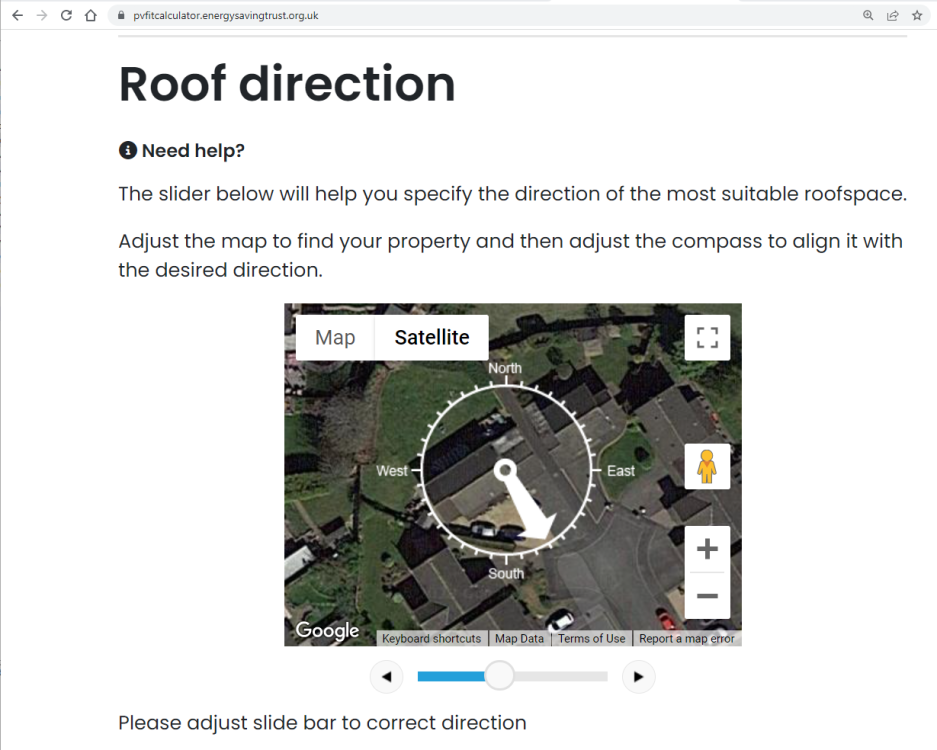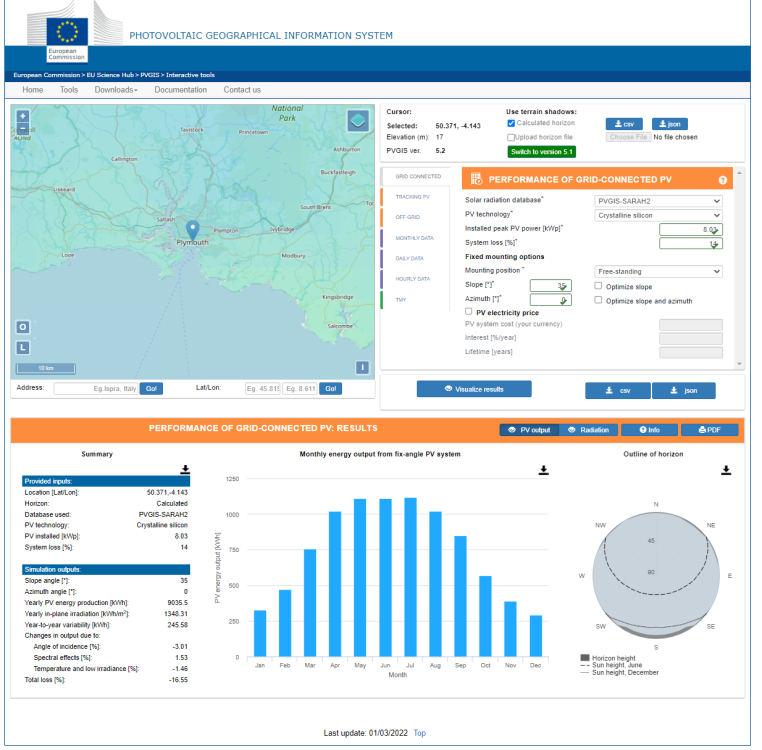
SimC
Members-
Posts
10 -
Joined
-
Last visited
Personal Information
-
Location
East Midlands
Recent Profile Visitors
The recent visitors block is disabled and is not being shown to other users.
SimC's Achievements

Member (3/5)
8
Reputation
-
Clean Heat Market Mechanism to incentivise heat pumps
SimC replied to LnP's topic in Air Source Heat Pumps (ASHP)
The PVGIS default value of 14% system losses are not all down to conversion and transmission losses, a proportion is due to the degrading performance of the panels as they age over their lifetime. Many panels are rated at 98% after year 1 and down to 86% at year 25, so you could assume a mean value of 92% (8% loss) over the lifetime. Here is the relevant extract from the PVGIS user manual. -
It does not seem to be best use of hydrogen in a fixed location such as a distillery. Electrification would in my mind be a better solution, and not reliant on a single source of supply of hydrogen. In my day job I have come across a few recent examples of cascaded ASHP and WSHP in order to achieve suitable grade heat for hospitals including for their DHWS which is required at least at 60 C for protection against legionella in areas for vulnerable patients. This must be somewhere near the grade of heat required for distillation.
-
My concern would be how to modulate/balance the water flow rates through the currently active heat source with that through the total of 5 pumps serving the loads. There would appear to be a total of 7 pumps required in the system, assuming 1 in the outside ASHP and 1 in the system boiler. Too low a flow rate through the heat source, and the manifold ends up containing predominantly cool return water from the loads so not meeting the load heating requirements. Too high a flow rate through the heat source, and the manifold ends up containing predominantly hotter water from the heat source resulting in a high return temperature to the heat source with its knock on effect on the COP/efficiency.
-
You could have an 8kW inverter with a 3.68 kW DNO export limit. How any inverter achieves this is by having it's own metering device next to your utility meter (or along the route of the main live cable from the utility meter). The inverter then has a live import/export power value that can be limited to whatever value is programmed in. The value is password protected so that only the installer and manufacturer can set or change it. The inverter has power point trackers on the PV string inputs, that it can set for maximum/optimal output from the panels, or when the export limit is being reached the trackers adjust to non-optimal to reduce the electrical power output of the panels. The excess solar energy is then just dissipated as heat in the panels. Solar panels are only around 20% efficient at generating electricity, so already dissipate 80% as heat meaning another few % due to the DNO export limit is not going to cause any damage. Have you got a logical position for the inverter and batteries, bearing in mind there needs to be suitable cable routes for the DC feed from the panels, the ac power cable to a suitable consumer unit breaker, along with a data cable to the metering device? Batteries are very heavy, so ideally on the ground floor. Depending on your building layout, a garage can be the best location, but only you know the layout.
-
One solar performance website is:- https://re.jrc.ec.europa.eu/pvg_tools/en/#PVP Here is one example of a thread from this forum (the advanced search with 'wall pv' is your friend).
-
Battery storage (or any storage) comes in to play when your solar generation profile does not align with your consumption profile, instant by instant over each day. If at one instant in time the PV is generating 5 kW, and your consumption is 2 kW with no storage available, then the 3 kW excess has nowhere to go other than export to grid (potentially at 15p/kWh from Octopus). If at a later instance in time the PV is generating 2 kW with a 5 kW load, then you have a 3 kW import from grid (potentially at 33p/kWh on the price cap). The battery storage will save any excess solar generation during the day, for consumption later whilst avoiding the cost of grid import. Whilst waiting for my battery install (on a long lead time), I have a solar diverter (MyEnergi Eddi) connected to the hot water immersion heater and 2 oil filled heaters. As soon as the diverter detects any grid export it diverts just the excess power to the immersion heater. Once the immersion is up to temperature, it automatically switches to the heaters. The diverter is fully automatic, so when the solar gen drops off or a household load is switched on, a grid import is detected so the power diversion drops to 0. Assuming your grid export price is less than grid import (almost always the case), you get the fastest payback on the solar PV when you self consume as much of the generation as possible. Energy storage helps with this, as long as it is suitably sized to your generation and consumption profiles.
-
For the PVGIS solar output calculator:- Choose your location, even down to your street level. Input the PV peak power (approx 3.0 East, 5.0 West). Slope = angle of roof from horizontal. Typically 30 to 35 degrees for a UK roof. May be your roof builder can provide this figure, or by measurement and trigonometry where the angle = tan[-1] (vertical distance/horizontal distance) of the right-angle triangle formed by half your roof. For example, angle = tan[-1] (2.5m/4m) = 32.0 degrees. Azimuth = angle from due South (so due South = 0, East = -90, West = +90 degrees) Click the 'Visualise results' button to see the predicted kWh output per month. If the azimuth angle is not obvious, you can get a figure to the nearest 10 degrees (possible 5 if between graduations) by using this link, enter your postcode, then move your property under the pointer on the map. Each graduation is 10 degrees, so count from due South. Repeat for each of your roof slope directions. This example is -30 degrees from due South.
-
As others have said, you really need to understand how your 3 phase supply is going to be utilised and what electrical loads will be presented on each of the 3 phases. It may be a legacy use of the property that powered 3 phase motors/machinery. For example a 3kW 3-phase motor will put an even 1 kW load on each phase, whereas a 2 kW 1-phase washing machine will put the full 2 kW load on 1 specific phase based on which it is wired to. Another brand of 3-phase inverter mentions being able to cope with out of balance loads across the 3-phases, with up to 5 kW output on 1-phase from an 8 kW inverter. https://midsummerwholesale.co.uk/buy/solax/solax-x3-g4-fit-8-tp30 Another consideration is the location of the grid incomer (plus utility meter) in relation to where the inverter will be located. The inverter will require a suitably rated power cable, along with a data cable to it's own 3-phase meter. This is so the inverter knows what loads are present on each phase and also once a battery is added what output it needs to provide in order to target zero grid import which minimises your bills. If you want to be paid for export, the installer will need to be MCS approved and provide a certificate for your installation along with DNO approval for connecting the system to the grid.
-
Starting with the solar panels part, REC is the manufacturer with a good reputation for reliable products. If they are installed by an 'REC Pro Installer' then you get a 25 year warranty on the panels that includes the labour costs to swap out any that fail. Check this link for your local installers. https://www.recgroup.com/en/installers/search The GSE integration is a mounting system for the panels that fixes directly to the roof slats, so the panels become part of the weather proof cover for the roof with the edges filled in with normal roof tiles. Presumably this is for a new or replacement roof project. With 22 x 365 Watt panels, the peak output in Summer with all at the optimum slope angle on a South facing roof would be 8030 Watts (8.03 kWpeak). But is your roof area all South facing, and big enough to contain all 22 panels, or do you have East and West roof areas big enough for say 10 and 12 panels? To cater for different alignment of roof areas, the inverter has 2 string inputs that operate independantly to optimise the output of the connected panels. So you could have say string 1 of 10 panels for the East roof, and string 2 of 12 panels for the West roof. You can get a prediction of the panel performance for your location and roof layout by using this calculator:- https://re.jrc.ec.europa.eu/pvg_tools/en/ Choose your location, even down to your street level. Input the PV peak power (all 8.03 if all facing in the same direction). Slope = angle of roof from horizontal. Azimuth = angle from due South (East = -90, West = +90) Click the 'Visualise results' button to see the predicted kWh output per month. Run the report twice with different PV peak power and azimuth if you have 2 roof areas, then add the monthly results together.
-
Is that 100 mm too tall per panel, or for the whole height of 2 portrait panels including the required spacing between (usually around 24 mm)? The JA Solar 395W are 1722 mm tall (in portrait), and the Perlight 295W are much less at 1504 mm and significantly lower output. There is a Perlight 400W panel that is 1646 mm tall, that may fit, and will keep the total output up at your original target.






